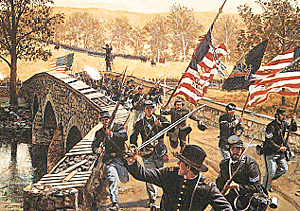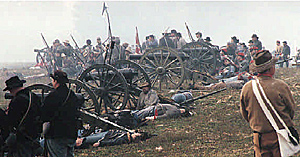 James M. McPherson
James M. McPherson
Crossroads Of Freedom: Antietam
New York: Oxford University Press, 2002
203 Pages; $26.00
James McPherson is one of the elite of the current generation of Civil War historians, a scholar whose name is instantly recognizable to nearly everyone interested in the conflict. Furthermore, like others at the top level of Civil War writing-----Shelby Foote, Henry Steele Commager and Bruce Catton------he is a master of the narrative, a skilled writer who weaves his scholarship into a compelling story that appeals to an audience wider than the immediate circle of his peers.
Antietam: Crossroads of Freedom is examines what he argues to be the real turning point of the War Between the States. It is presented as part of a series called Pivotal Moments in American History, which editor David Hackett Fischer describes in his preface as intended to “encourage interest in problems of historical contingency.” Sometimes called contrafactuals and sometimes “What if’s,” this approach goes directly to the consequences of an event or episode; equally important, it looks at the possible results had the outcome been different.
McPherson’s newest book is defined as well by what it is not. Antietam: Crossroads of Freedom is not a detailed description of the battle and the campaign, complete with regimental orders of battle and a minute-by-minute rendering of small unit actions. Indeed, his treatment of the actual battle at Sharpsburg, Maryland is fairly cursory, capturing the general outlines, but seldom looking at command decisions below the level of the armies their corps.
On the other hand, he deftly employs many first-hand accounts to capture the fury and horror of the bloodiest single day in American history. It amounts to one of the book’s best features: McPherson draws upon a large cast of long-passed co-authors, from whom he quotes extensively. When he cannot express a thought any better, he has the wisdom to defer to the witnesses and participants.
What really distinguishes this slim volume is its perspective. Consistent with the mission of the series as expressed by its editor,
Antietam: Crossroads of Freedom places the battle in the terms of a much larger picture. McPherson devotes much of the book’s beginnings to the strategic ebb and flow of the Civil War’s first two years, portraying shifts in momentum that lead to alternating exuberance and despair on each side. New Orleans falls, and the North exalts; Pope is savaged at Second Bull Run, and Confederate morale reaches for the sky.
All the while, Europe watches. McPherson’s gaze extends to London and Paris, where the governments of Palmerston and Napoleon III wait for Southern arms to demonstrate the new Confederacy’s ability to survive. Should they succeed, as they very nearly did at Second Bull Run, Anglo-French “mediation” promises de facto recognition, almost as good as outright intervention.
This is the framework into which the author places Antietam. If Robert E. Lee and the Army of Northern Virginia could win a signal victory north of the Potomac, that could provide sympathetic elements in Europe the rationale they need to offer recognition. As McPherson shows, some success in the invasion of Maryland might instantly overcome all the defeats of Forts Donnelson and Henry, Shiloh and New Orleans.
His employment of first-hand primary sources forms a vivid picture of how Lee’s operation was perceived as a failure. First, despite expectations that Marylanders would flock to the Stars and Bars upon seeing his army in Frederick, the Confederates were received with sullen hostility by the largely pro-Union population of western Maryland. Besides, the sad appearance of his units, dressed in rags and with many troops lacking shoes, was not likely to impress anyone with the look of a winner.
The battle itself was not seen as the stalemate as modern historians tend to depict it, and again the author defers to the contemporaries. He shows that at the time, observers largely saw Antietam as one more major defeat for the South. In fact, after the Union’s reverses in the East-----all the more striking considering the victories by the Western armies-----Antietam might be seen as the clash in which the Army of the Potomac finally showed that it really could stand and fight Lee and his lieutenants.
That McClellan, ever adverse to even the shadow of risk, never followed up with a pursuit of the enemy was not important, at least immediately after September 17, 1862. At the time the important fact was that the Army of Northern Virginia had been stripped of their aura of invincibility.
 At no other time would recognition by Britain or France be so likely as it was right before Antietam. Then
soon afterward, it would evaporate into nothing. That amounts to one of the main reasons why McPherson argues
that Antietam, and not Gettysburg, was the real turning point of the Civil War.
At no other time would recognition by Britain or France be so likely as it was right before Antietam. Then
soon afterward, it would evaporate into nothing. That amounts to one of the main reasons why McPherson argues
that Antietam, and not Gettysburg, was the real turning point of the Civil War.
It was pivotal for a second reason. Antietam gave Abraham Lincoln the political capital he needed to issue the Emancipation Proclamation. McPherson makes a clear distinction between the war to restore the Union as it was before, that is the Union with slavery, to the war to restore the Union in a form much improved, that is without slavery. Despite the protests of Northern “Peace Democrats,” who amounted to a pro-Confederate faction within the Federal body politic, and the “War Democrats,” who advocated the restoration of a Union tolerant of slavery, Antietam insured that it would be an abolitionist war.
The author places this pivotal change on two levels.
On the geopolitical level of realpolitik, connecting the Northern cause to the abolition of the peculiar institution made Confederate cause sufficiently unpalatable to Europeans that they could never justify intervention in favor of slaveholders on moral grounds.
Second, there is the moral value of Antietam and the consequent Emancipation Proclamation, which end up with pride of place in McPherson’s appraisal of the campaign. As the title indicates, he sees it as the pivotal event in American history that eliminated the chance of compromise with the inexcusable, and truly turned the Civil War into a war for liberation.
The true value of Antietam: Crossroads of Freedom lies not in new revelations of the Battle of Antietam. Nonetheless it offers new perspectives on its subject, not in terms of the detail of the combat, but at least as important, in the generalities of the politics and morality of the war. James McPherson does so with all the clarity of thought and language one expects of him.
Back to Cry Havoc #40 Table of Contents
Back to Cry Havoc List of Issues
Back to MagWeb Master Magazine List
© Copyright 2002 by David W. Tschanz.
This article appears in MagWeb (Magazine Web) on the Internet World Wide Web. Other military history articles and gaming articles are available at http://www.magweb.com